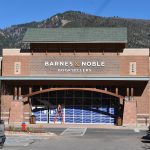Justice Department says Trump has power to rescind national monument designations
The Justice Department issued an opinion that contradicts the guidance it has followed for 87 years on the presidential powers held in the Antiquities Act

Chris Dillmann/Vail Daily archive
President Donald Trump’s administration appears poised to rescind some of the national monuments created by past presidents.
The U.S. Department of Justice released a legal opinion on Tuesday, June 10, stating that Trump has the authority to do so, contradicting how the department has interpreted the Antiquities Act for 87 years.
The Antiquities Act of 1906 grants United States presidents the authority to create national monuments to protect historic landmarks, structures and objects of historic or scientific interest. Since President Theodore Roosevelt established Devils Tower in Wyoming as the first national monument in September 1906, all but three U.S. presidents — Richard Nixon, Ronald Reagan and George H. W. Bush — have used the act to establish or expand over 160 dedicated areas. Colorado has nine.
Mark Squillace, a legal professor at the University of Colorado Boulder specializing in natural resources law, said it sends a clear signal “that the Trump administration is setting themselves for a better legal position when they take some of these actions to revoke some of the Biden monuments, maybe some of the old Clinton monuments as well as Obama monuments.”
Can presidents rescind or alter national monuments?
The Justice Department opinion, signed by Lanora Pettit, deputy assistant attorney general in the department’s office of legal counsel, addresses one main question about the nearly 120-year-old law: Does the Antiquities Act grant presidents the ability to rescind or alter national monuments?
“We think that the President can, and we should,” Pettit writes.
Pettit argues that the Antiquities Act has become abused by presidents who have “used that (sweeping, unilateral) power to withhold vast swaths of the American land- and seascape from potentially beneficial economic use.”
The opinion follows actions from Trump, Congress, and the U.S. Department of the Interior to pull back safeguards on public lands, including designations like national monuments, in favor of development and restoring “multiple use” principles on public land.
These actions also mirror recommendations for the Interior Department from Project 2025, the conservative playbook created before Trump’s second presidency. The plan recommended that the agency repeal the Antiquities Act, defend the president’s ability to reduce monument sizes and review all national monuments dedications, which it alleges have been abused by every Democratic president since Jimmy Carter.
The last time the Justice Department issued an opinion on the issue was 1938, under Democratic President Franklin Roosevelt, who was considering abolishing the Castle Pinckney National Monument in Charleston, South Carolina. It concluded that the Antiquities Act did not grant authority to remove national monument dedications.
The new opinion from the Trump administration reported that the 1938 declaration was incorrect. It points to the controversy and differing opinions lawmakers held during the creation of the Antiquities Act, past presidential actions to reduce monument sizes and more to make its argument.
Squillace said that he agrees with the interpretation under the 1938 opinion.
“They don’t really address this in the new opinion, but the old opinion quite clearly demonstrated that there were statutes that were passed around the same time as the Antiquities Act that specifically gave the president what I refer to as two-way authority, that they could designate or revoke certain kinds of public land withdrawals,” he said. “The Antiquities Act only gives one-way authority. It quite clearly says only that the president can reserve public lands as national monuments. It says nothing about his authority to revoke or diminish a monument.”
The authority to alter or remove a national monument declaration has remained with Congress, Squillace said.
“If there’s any particular concern about a national monument, Congress can shrink it. It can rescind it. It can do whatever it wants to a particular national monument,” he said. “It is instructive that the Congress has never revoked or even really shrunk significant national monuments in any way.”
Squillace noted there have been a few “small monuments” that Congress retracted when the objects the monuments were created to protect were gone or when lawmakers turned over to states for protection.

With the 1938 opinion setting a boundary, no other presidents have attempted to revoke national monuments. However, there have been examples of monuments being reduced.
This includes President Woodrow Wilson’s 1915 order to shrink Mount Olympus National Monument and President Dwight Eisenhower’s reduction of six monuments, including the Great Sand Dunes in Colorado. (All six have since become national parks.)
In his first presidency, Trump ordered a review of national monuments, which resulted in the reshuffling of management terms and the reduction of two Utah monuments — the Grand Staircase-Escalante National Monument and Bear Ears National Monument. He also ordered changes to New England’s Northeast Canyons and Seamounts Marine National Monument to open up commercial fishing opportunities.
The Justice Department’s latest opinion argues that if a president can shrink a monument, it can eliminate it, and that past presidential actions set a precedent for reductions.
It stipulates that, because under the Antiquities Act, monuments must be “‘confined to the smallest area compatible with the proper care and management of the objects to be protected,'” this can “have the effect of eliminating entirely the parcel previously associated with a national monument.”
However, in Squillace’s opinion, neither is allowed under the Antiquities Act’s “one-way authority.”
“I don’t think it proves anything to say that presidents have shrunk monuments in the past. My view is that those were largely illegal shrinkages, but nobody challenged them,” he said. “We don’t know what the courts might say about the authority to shrink.”
This question, however, has been central to the litigation around Grand Staircase-Escalante and Bears Ears, which environmental groups challenged in Trump’s first presidency. Biden restored the monuments as this litigation was ongoing. Squillace, who wrote an amicus brief in support of the Grand Staircase, said this issue has never been fully resolved.
While they have yet to rule on this specific legal question, courts, including a 1920 Supreme Court case involving the Grand Canyon, have upheld the president’s power to designate and determine how much land to protect within a national monument.
Regardless of the Justice Department’s new opinion, Squillace expects any decision from Trump to rescind a national monument will be challenged.
“There’s going to be a lot of pushback and we’re going to have litigation almost for sure,” he said. “At some point, this issue may end up in the U.S. Supreme Court. Presidents are probably going to continue to use this as long as they have the power. We’ll see if the courts try to constrain that power in some fashion. But I’m somewhat optimistic that we’re going to be able to keep the Antiquities Act more or less the way it has been for almost 120 years now.”
Any decisions, Squillace added, could still impact public lands. While the next president could reverse any action from Trump — similar to the back and forth between Trump and Biden over the two Utah national monuments — “there could be a lot of damage that’s caused in the intervening period.”
Which monuments is the Trump administration targeting and why?
It is unclear exactly which of the national monuments Trump could move to abolish or shrink.
The Justice Department’s opinion singles out two monuments in California: the Chuckwalla and the Sáttítla Highlands National Monuments, which were dedicated in the last days of Biden’s administration.
In April, The Washington Post reported that six national monuments were on the administration’s list for reductions: Chuckwalla, Baaj Nwaavjo I’tah Kukveni-Ancestral Footprints of the Grand Canyon and Ironwood Forest in Arizona, Bears Ears and Grand Staircase in Utah, and Organ Mountains-Desert Peaks in New Mexico.
Any monument created by Biden could be targeted, including his first, the designation of 53,804 acres in Eagle and Summit counties as the Camp Hale-Continental Divide National Monument in October 2022. Project 2025 refers to this dedication as “outrageous, unilateral withdrawals from public use of multiple-use federal land,” which it claims was done against the objections of local groups.
Public land and environmental advocacy groups have pushed back on these actions against national monuments, citing the vast public, bipartisan support such protections have, including in the case of Camp Hale.
The 2025 Conservation in the West Poll surveyed over 3,000 registered voters in eight Western states, including Colorado, about conservation and public lands issues.
In Colorado, 92% of voters polled, regardless of political affiliation, said they felt national monument designations from the last decade should be kept in place. In the past 10 years, Obama, Trump and Biden dedicated 30 new monuments. This support was seen across the West as well, with 89% reporting these designations should be kept. For self-reported MAGA supporters, this number was 81% and 94% for all other voters.
“Fifty dense pages from the Trump Administration’s Justice Department attempting to rewrite history will not change the overwhelming support Americans have for national monuments,” read a statement from The Mountain Pact, a public land advocacy group based in Durango.

Support Local Journalism

Support Local Journalism
Readers around Glenwood Springs and Garfield County make the Post Independent’s work possible. Your financial contribution supports our efforts to deliver quality, locally relevant journalism.
Now more than ever, your support is critical to help us keep our community informed about the evolving coronavirus pandemic and the impact it is having locally. Every contribution, however large or small, will make a difference.
Each donation will be used exclusively for the development and creation of increased news coverage.










